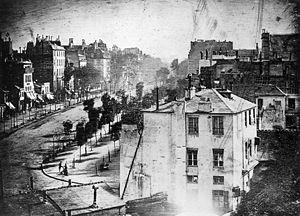Today in 1839, the Daguerreotype process was presented to the French Academy of Sciences by Francois Arago, a physicist and politician. Arago told the Academy that it was “…indispensable that the Government should compensate M. Daguerre, and that France should then nobly give to the whole world this discovery which could contribute so much to the progress of art and science.”
On March 5, 1839, another inventor looking (in the United States, England, and France) for government sponsorship of his invention, met with Daguerre. A highly impressed Samuel F. B. Morse wrote to his brother: “It is one of the most beautiful discoveries of the age… No painting or engraving ever approached it.”
looking (in the United States, England, and France) for government sponsorship of his invention, met with Daguerre. A highly impressed Samuel F. B. Morse wrote to his brother: “It is one of the most beautiful discoveries of the age… No painting or engraving ever approached it.”
In late September, as Jeff Rosenheim tells us in Art and the Empire City, shortly after the French government (on August 19) publicly released the details of the Daguerreotype process, “…a boat arrived [in New York] with a published text with step-by-step instructions for creating the plates and making the exposures. Morse and others in New York, Boston, and Philadelphia immediately set about to build their cameras, find usable lenses, and experiment with the new invention.”
New Yorkers were ready for the Daguerreotype, already alerted to the “new discovery” by articles in the local press, such as the one in The Corsair titled, “The Pencil of Nature” (April 13): “Wonderful wonder of wonders!! … Steel engravers, copper engravers, and etchers, drink up your aquafortis, and die! There is an end to your black art… All nature shall paint herself — fields, rivers, trees, houses, plains, mountains, cities, shall all paint themselves at a bidding, and at a few moment’s notice.”
William Howarth paints for us (in Civilization, March/April 1996) the larger picture of the new industry in America: “Daguerreotypes introduced to Americans a new realism, a style built on close observation and exact detail, so factual it no longer seemed an illusion. … Hawthorne’s one attempt at literary realism, The House of the Seven Gables (1851), features a daguerreotypist who uses his new art to dispel old shadows: ‘I make pictures out of sunshine,’ he claims, and they reveal ‘the secret character with a truth that no painter would ever venture upon.’… By 1853 the American photo industry employed 17,000 workers, who took over 3 million pictures a year.”
A hundred and fifty years later, the Metropolitan Museum of Art mounted an exhibition on the early days of Daguerreotypes in France. Said Philippe de Montebello, the director of the museum at the time: “The invention of the daguerreotype—the earliest photographic process—forever altered the way we see and understand our world. No invention since Gutenberg’s movable type had so changed the transmission of knowledge and culture, and none would have so great an impact again until the informational revolution of the late twentieth century.”
In the same year of the Metropolitan’s exhibition, 2003, more digital cameras than traditional film cameras were sold for the first time in the U.S. Four years later, Facebook stored 1.7 billion user photos and served every day more than 3 billion photo images to its users. According to the latest statistics from Facebook, its users uploaded around 300 million photos each day.
The “informational revolution” has replaced analog with digital, but it did not alter the idea of photography as invented by Nicéphore Niépce in 1822, and captured so well by the inimitable Ambrose Bierce in his definition of “photograph” (The Devil’s Dictionary, 1911): “A picture painted by the sun without instruction in art.”
See Also: First US Photography Patent, Instant Photography, “The Mirror with a Memory”, First Photo Studio



excelente post , date una vuelta por mi sitio
LikeLike